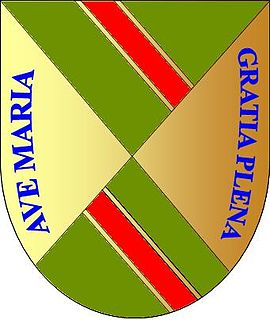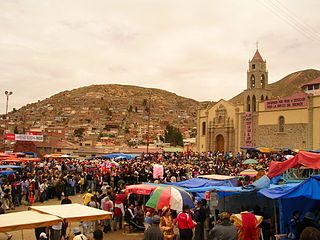
La Paz, officially known as Nuestra Señora de La Paz, also named Chuqi Yapu (Chuquiago) in Aymara, is the seat of government and the de facto national capital of the Plurinational State of Bolivia. With an estimated 789,541 residents as of 2015, La Paz is the third-most populous city in Bolivia. Its metropolitan area, which is formed by La Paz, El Alto and Viacha, makes up the most populous urban area in Bolivia, with a population of 2.3 million. It is also the capital of the La Paz Department.

Ladislao Cabrera is a province in the southern parts of the Bolivian department of Oruro. It is named after Ladislao Cabrera. Its seat is Salinas de Garci Mendoza.

The Vice President of the Plurinational State of Bolivia or Vice President of Bolivia, is the second highest political position in Bolivia. The Vice President replaces the President in his definitive absence or others impediment and is the President of the Legislative Assembly.

Torrelavega is a municipality and important industrial and commercial hub in the single province Autonomous Community of Cantabria in northern Spain.

Municipalities in Bolivia are administrative divisions of the entire national territory governed by local elections. Municipalities are the third level of administrative divisions, below departments and provinces. Some of the provinces consist of only one municipality. In these cases the municipalities are identical to the provinces they belong to.

Salinas de Garci Mendoza is a town in the Bolivian Oruro Department. It is the administrative center of Ladislao Cabrera Province and is located 280 km (170 mi) south-west of Oruro, the capital of the department. It is situated at an elevation of 3,732 m (12,244 ft) at Caricha, 20 km north of the Tunupa stratovolcano. Salar de Coipasa,a salt lake, is 20 km north-west of Salinas de Garci Mendoza, and 15 km in south-eastern direction is Salar de Uyuni, the world's largest salt pan. Salinas de Garci Mendoza is the endpoint of the road from Chuquichamba via Andamarca and Aroma to Salinas de Garci Mendoza.

The Bolivian general election, 2009 was held on December 6, 2009, following a constitutional referendum held on 25 January 2009. Voters elected:
Pablo Antonio Salinas Menchaca is a Bolivian football forward who currently plays for Club Destroyers.

San Benito or Villa José Quintín Mendoza is a location in the Cochabamba Department in central Bolivia. It is the seat of the San Benito Municipality, the third municipal section of the Punata Province.
Alonso de Mendoza was a Spanish captain, conquistador, and the founder of the city of Nuestra Señora de La Paz, current capital city of Bolivia. He was appointed by Pedro de la Gasca, the "Peacemaker," to found the city to commemorate the peace in the Peruvian colonies after the defeat of the Pizarro brothers.
Unofficial South American Championships in Athletics were held in La Paz, Bolivia in October 1948. The event was held in celebration of the 400th anniversary of the foundation of the city of La Paz. The games were dominated by Bolivian athlete Julia Iriarte winning five gold, one silver and one bronze medal.

Garci Álvarez de Toledo y Meneses was a Spanish noble of the House of Oropesa. He was the Grand Master of the Order of Santiago from 1359 to 1366.

Jayu Quta is a maar partially filled with water, in the Bolivian Altiplano, north of the Salar de Uyuni and east of the Salar de Coipasa. It is situated in the Oruro Department, Ladislao Cabrera Province, Salinas de Garci Mendoza Municipality, Villa Esperanza Canton. It was originally misidentified as a meteorite impact crater.

Leonor Lasso de la Vega was a Spanish noble woman from Cantabria and head of the prestigious House of Lasso de la Vega from 1367 - 1432.

The House de la Vega, Laso de la Vega or Lasso de la Vega is a Spanish noble line from the Kingdom of Castile. The family origins lie in the areas now known as Torrelavega which was established in the Middle Ages. The House of de la Vega was one of the most important families in the territory which now makes up Cantabria and they dominated a large amount of the terrain and property between the Torre de la Vega and the Castillo de Argüeso.

Pukintika is a volcano in the Andes, about 5,407 m (17,740 ft) high, situated in the Cordillera Occidental on the border of Bolivia and Chile. It is located in the Arica and Parinacota Region of Chile and the Oruro Department of Bolivia. Pukintika lies to the north of the Salar de Surire, east beside Arintika volcano which is younger than Pukintika. Pukintika also features a crater lake with a surface area of 2,500 square metres (27,000 sq ft). Deposits of elemental sulfur have been found on Pukintika.

Ch'iyar Qullu is a volcanic centre in Bolivia. It is located in the Oruro Department, Ladislao Cabrera Province, Salinas de Garci Mendoza Municipality, northeast of Salinas de Garci Mendoza, near a maar named Jayu Quta.

Sallani Yapu is a 4,224-metre-high (13,858 ft) mountain in the Andes of Bolivia. It is located in the Oruro Department, Ladislao Cabrera Province, Salinas de Garci Mendoza Municipality. It lies north of the Uyuni salt flat.
Salinas is a lake event in the Salar de Uyuni, Bolivia.


















